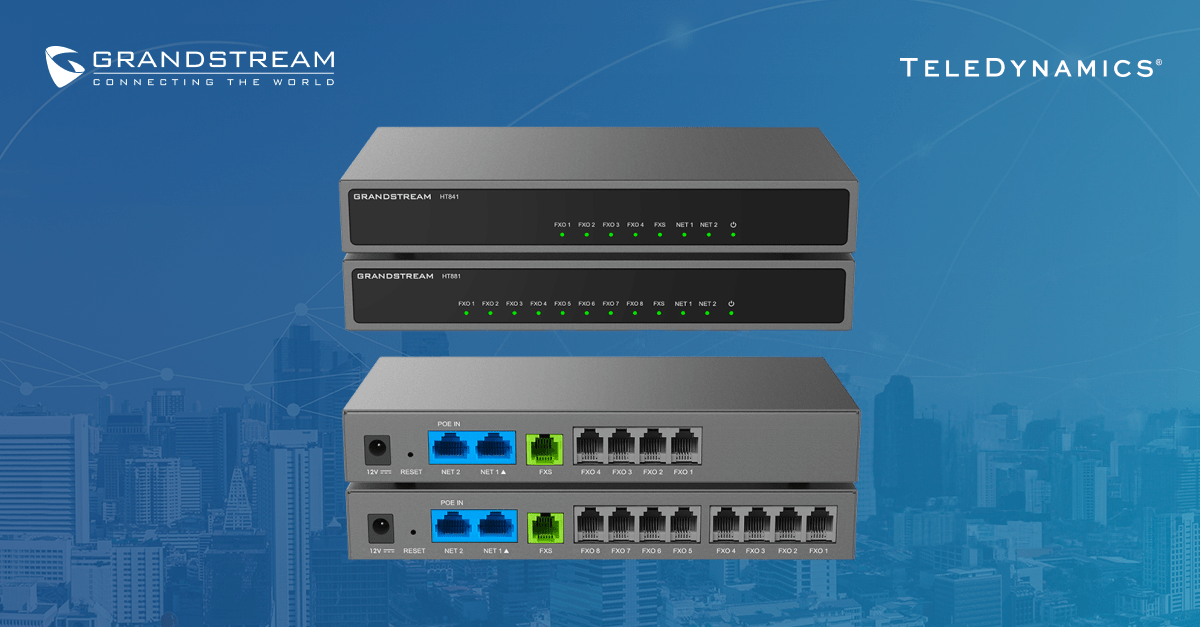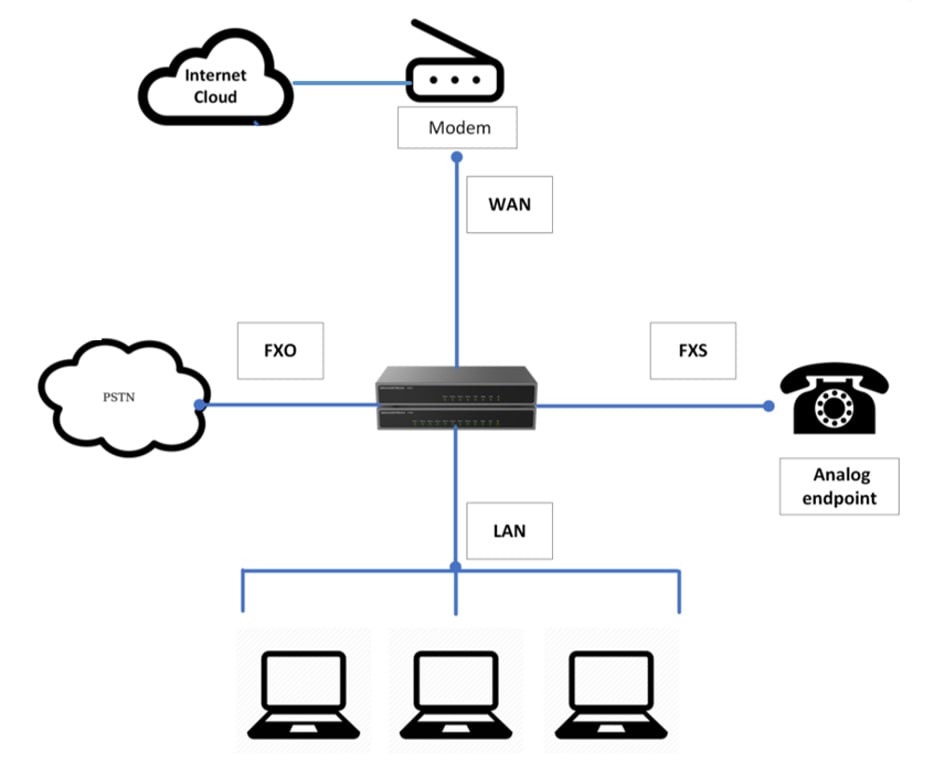
Grandstream recently announced a pair of new FXO gateways, the HT841 and HT881, that allow small to medium-sized businesses to deploy VoIP services easily and quickly in an environment where analog telephony is still prevalent.
In this article, we review these new devices and discuss some of the use cases that these devices were designed to serve.
The case for analog telephony
Direct migration from conventional telephony to a VoIP-based system isn’t always practical. In many cases, it may be necessary to have a transitional phase where both VoIP and analog telephony components are used concurrently. This usually happens due to budget constraints but sometimes occurs because VoIP technology is either not accessible or suitable for deployment in a particular area.
Grandstream’s HT841 and HT881
Grandstream’s new HT841 and HT881 FXO voice gateways bridge the gap between analog and IP telephony, both figuratively and literally. These state-of-the-art devices easily integrate analog telephone lines into your VoIP telephony solution.
Both devices have a set of FXO ports designed to connect to plain old telephone service (POTS) lines coming directly from the telco or an analog PBX. The gateway, in turn, interconnects with a SIP server, such as the UCM6000 series IP PBXs, allowing the analog telephone network to communicate with the VoIP domain seamlessly.
Connectivity and network role
Both devices allow your internal VoIP environment to support calls to and from PSTN lines. Each gateway can also be a default network gateway for the local LAN, delivering routing capabilities and network services like DHCP and NAT.
Sporting two Gigabit Ethernet ports—one for the local LAN and one for connection to the WAN—they can be a simple edge network device, which is ideal for remote offices or small businesses. The WAN port can be used to connect to the internet or a private network (via VPNs, MPLS, Metro Ethernet, or other technologies), depending upon the requirements of your organization.
The gateways also provide a single FXS port, where an analog endpoint—such as a telephone, a fax machine, or even an older PA system—may be connected. The following diagram* depicts an example of how you can connect the HT841 and HT881 gateways in network topology:

The FXO connections shown above may either be to PSTN lines from the telco or analog circuits from a traditional PBX. You can also see how the workstations on the LAN can connect to the gateway, which connects to the internet. Finally, you can also see the single analog endpoint that can be connected to the FXS port.
The following diagram* further describes the capabilities of interconnection with a SIP server.
.png?width=770&height=565&name=fxo%20gateway%20connected%20to%20sip%20server%20(ok).png)
The gateway can connect to the SIP server in one of two ways:
- Using SIP accounts: In this case, the gateway will register to the SIP server with the appropriate credentials, making the gateway act as an SIP endpoint. When calls are made from an IP phone, they are routed to one of the SIP accounts, which then forwards the call to one of the PSTN lines.
- Without SIP accounts: Here, the SIP server must be configured to send a SIP INVITE message with the FXO destination number to the gateway’s IP address. Once received, the gateway will immediately forward these calls to the FXO line.
Key features of the HT841 and HT881
The HT841 and HT881 replace the older GXW4104 and GXW4108 models, respectively, providing a richer feature set and more powerful options.
Like their predecessors, they each offer PSTN failover in case of a power failure and support T.38 Fax over IP standards. However, these new gateways deliver much more than their predecessors, including:
- A single FXO port to connect any analog endpoint
- Automated and secure provisioning using TR069
- Support for 3 SIP profiles for registration with an SIP server
- NAT, DHCP, and routing capabilities
- A failover SIP server that automatically switches to a secondary server if the primary server fails
- Three-way voice conferencing per port
- Two Gigabit Ethernet ports for LAN/WAN connectivity
- The ability to be powered by PoE via the Net2 port (LAN port)
- Support for Secure RTP (SRTP), SIP Secure (SIPS), and Transport Layer Security (TLS)
- Support for most modern network features, including QoS, STUN, SSH, and TFTP
The only difference between the HT841 and the HT881 is the number of FXO ports available: The former has four, while the latter has eight. Which to choose strictly depends upon the number of analog circuits you want to connect to your VoIP network.
Use case scenario
To further illustrate the potential of these voice gateways, consider a small branch office of a large corporation with about 15 employees that is currently utilizing an analog PBX system with multiple extensions and a fax machine.
The company seeks to integrate this branch office’s telephone system with its centralized VoIP system without initially replacing any of the analog devices already installed. Using either the HT841 or the HT881 analog voice gateway is an ideal solution.
By installing these devices, the branch office can integrate its existing analog phones and fax machines into the corporation’s VoIP network, effectively bridging the old and new technologies. This setup allows the firm to enjoy all the benefits and features of VoIP without the need to purchase new equipment.
These gateways enable a cost-effective transition. They allow businesses to continue using their familiar analog devices, reducing the learning curve for employees. Moreover, as the business grows, the firm can easily connect more analog devices or gradually introduce IP phones into their networks, leveraging the scalability offered by the HT841 and HT881 gateways.
Conclusion
In a telecom landscape where analog telephony persists, Grandstream provides devices that allow companies to enjoy the best of both analog and VoIP telephony with a hybrid system.
The Grandstream HT841 and HT881 gateways provide a seamless, reliable, and cost-effective solution for businesses transitioning from traditional telephony systems to modern VoIP networks.
*These and other connection diagrams can be found in the HT841/HT881 user manual.
You may also like:
Grandstream GWN7816P layer 3 managed network switches
How to create site-to-site VPNs with Grandstream GWN routers
How to create VLANs with Grandstream GWN7800 series switches









Comments